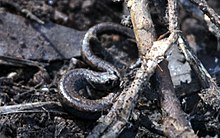
The Tehachapi slender salamander is a species of plethodontid salamander, and one of the larger members of genus Batrachoseps. It is endemic to California, in Kern County in the western United States.

The black-bellied slender salamander is a small species of salamander that is endemic to California.
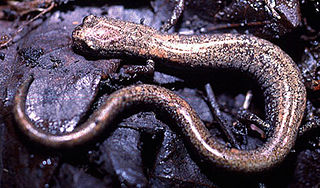
The San Gabriel slender salamander is a species of salamander. It has a worm-like body, a large head and large limbs, and an elongate cylindrical tail of less than 1.5 times its body length. An adult salamander is between 3 and 5 cm long. It has a black dorsum with white, coppery, and orange blotches, and an immaculate black venter. It may have red spots on tail.

The California slender salamander is a lungless salamander that is found primarily in coastal mountain areas of Northern California, United States as well as in a limited part of the western foothills of the Sierra Nevada, California, in patches of the northern Central Valley of California, and in extreme southwestern Oregon. This species resides primarily in a limited range within California as one of a handful quasi-endemic amphibians in the state.

The Oita salamander is a species of salamander in the family Hynobiidae endemic to Japan. Named after Ōita Prefecture, its natural habitats are temperate forests, rivers, intermittent rivers, freshwater marshes, intermittent freshwater marshes, and irrigated land in western Japan. It is threatened by habitat loss, due to the increasing construction of homes within its habitat. The Oita salamander is considered to be vulnerable by the (IUCN) Red List of Threatened Species with a declining population.

The Inyo Mountains salamander or Inyo slender salamander is a species of salamander in the family Plethodontidae that is endemic to the Inyo Mountains of California in the western United States.

The Gabilan Mountains slender salamander is a species of salamander in the family Plethodontidae. It is endemic to California in the United States, where it is distributed along the Central Coast region from Santa Cruz to northern Kern County.
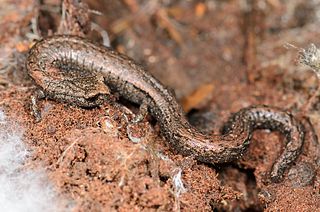
The gregarious slender salamander is a species of salamander in the family Plethodontidae. Its natural habitats are California interior chaparral and woodlands and temperate grasslands in the lower foothills of the western Sierra Nevada and the eastern Central Valley in California, United States.

The San Simeon slender salamander is a species of salamander in the family Plethodontidae.
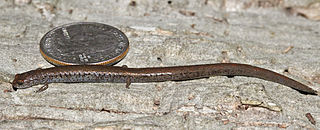
The Santa Lucia Mountains slender salamander is a species of salamander in the family Plethodontidae. It is endemic to California in the United States, where it is known only from Monterey County.
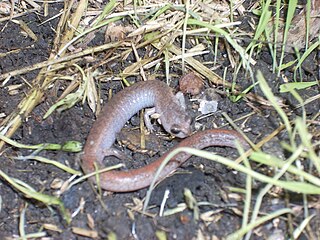
The Garden slender salamander or Southern California slender salamander is a species of salamander in the family Plethodontidae. It is endemic to northern Baja California in Mexico and Southern California in the United States.

The lesser slender salamander is a species of salamander in the family Plethodontidae.

The relictual slender salamander is a species of salamander in the family Plethodontidae. It is endemic to California, found only a small area in Kern County, California.
Thorius aureus, the golden thorius, is a species of salamander in the genus Thorius, the Mexican pigmy salamanders, part of the lungless salamander family. It is endemic to mountainous areas of north central Oaxaca State in Mexico. It is one of the largest Thorius species.

The California giant salamander is a species of salamander in the family Ambystomatidae. Dicamptodon ensatus is endemic to California, in the western United States. The species once additionally included individuals now belonging to the species D. aterrimus and D. tenebrosus, under the common name Pacific giant salamander, which now refers to the genus and family.
The mountain stream salamander or mountain stream siredon is a species of mole salamander that only lives in central México.
The wildlife of the Channel Islands of California is wide and diverse, including many endemic species. While the land wildlife is slightly limited, there being only one large, naturally predatory, and native mammal, the small island fox, marine life can include anything from kelp forests to great white sharks.
The Arguello slender salamander is a species of salamander in the family Plethodontidae. It is endemic to California, where it is found only in a small area of coastal Santa Barbara County.
